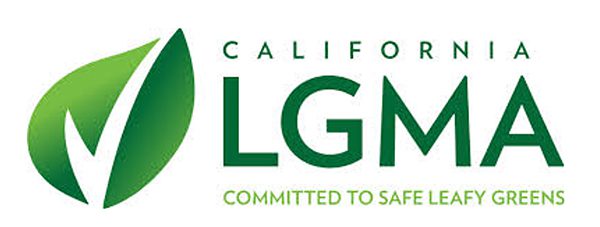FOR IMMEDIATE RELEASE September 16, 2020 Sacramento, CA — A survey of member companies operating under the California Leafy Greens shows that producers are capable of quickly tracking product involved in an outbreak or recall.
The Leafy Greens Marketing Agreement (LGMA) BB #:210653 is the only mandatory food safety program that requires leafy greens farms to have a system to trace product back to the field where it was grown and forward to the first customer who receives it.
“Verification that a traceback system is in place happens every time an LGMA member is audited by the government, which occurs about five times per year under our program,” said Scott Horsfall, CEO of the California LGMA which represents approximately 80 percent of the nation’s lettuce production. “We can say with confidence that 100 percent of our members have a traceback system in place.”
In an effort to learn more about the value of the LGMA traceability requirements and to assess the capabilities of member traceback systems, the LGMA conducted a survey of its membership.
Fifty-two of the California LGMA’s 93 members responded to a series of questions about their traceability programs, providing a 56 percent response rate. The respondents span a variety of operation types including large and mid-sized processors, large and mid-size commodity shippers and smaller specialty item grower shippers.
Survey results are available here.
“Through this survey we hoped to better understand how leafy greens producers’ traceback systems are contributing to outbreak investigations and determine if there are additional requirements that could improve the speed and accuracy in finding the source of future outbreaks that may be linked to leafy green farms,” said Horsfall, who noted the U.S. Food and Drug Administration has emphasized that improved traceback efficiencies could greatly enhance outbreak investigations.
“We’ve heard reports from government investigators that too many traceback systems involve antiquated paper-based systems,” said Horsfall. “We did find that some (15%) of our members use paper-based systems, but the majority (85%) are using electronic systems. More importantly, 100% of survey respondents reported they could trace product back to the field where it was grown in 2 hours or less, regardless of whether they had a paper-based or electronic system.”
Additionally, the survey found that 100 percent of survey respondents indicate their traceback systems capture information on activities involving growing and harvesting the product; 100 percent can identify the grower, ranch/field and date of harvest for all leafy greens they produce, and 96 percent are capturing information on the harvest crew who picked the product. All respondents report they test their traceback systems at least once per year to verify it is working.
“We also found that 63 percent of our members are utilizing the Produce Traceability Initiative, or PTI, for labeling and traceback.” said Horsfall, explaining that PTI is an effort developed in the produce industry over a decade ago to standardize tracking and tracing produce through the supply chain.
“What we can conclude from this survey is that LGMA members are collecting detailed information through their traceback systems” said Horsfall. “But, in practice, traceback systems within the supply chain are not working as quickly as needed to prevent.
“This underscores the need for the LGMA and the leafy greens industry to work more closely with the FDA to determine how traceback systems at the production end can better assist outbreak investigations,” he said.
Horsfall emphasized the LGMA supports an ongoing project coordinated by several food industry associations including United Fresh Produce Association and the Produce Marketing Association to examine and test traceback capabilities throughout the supply chain.
“The goal of this Leafy Greens Traceability Pilot is to explore what traceback information is needed to assist government investigations and to test how that information can quickly be shared in a format that allows it to connect the supply chain,” said Jennifer McEntire of United Fresh Produce Association, who is helping to coordinate the pilot. “The insights from the pilots will aid in more quickly and effectively locating the source of contamination during an actual outbreak.”
More information about the pilot is available at producetraceability.org.
Horsfall concluded, “As with any other aspect of our program, the LGMA is committed to making any necessary improvements to its required food safety practices to prevent future illnesses.”
Contact: April Ward
april@lgma.ca.gov



